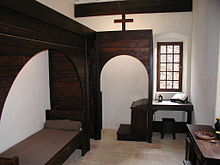Monastery cell


A monastery cell (kirchenlat .: Cella , small room, basement), (usually simple cell is called) a room or even a the monastery connected small house in the enclosure area of the monastery where a monk or a nun lives.
The cells or the cell corridor, which can be called the dormitory , is a central part of the exam . A monk's or a nun's cell is entirely private. It is the prayer and sleeping room of every individual and may only be entered by others in exceptional cases. The cell is a place of encounter with God.
history
In eastern monasticism , the so-called “kellion”, plural “kellia” (Greek), the apartment of a hermit or monk , was known from the beginning . Depending on the circumstances, one can imagine a mud hut with a courtyard (monk colonies in the Egyptian desert) or a cave built into a dwelling with a wooden platform and ladders (Palestine, Syria). The monk fathers spent their time in such dwellings, e.g. B. sat on a mat and braided ropes.

Excavations of Egyptian monks' dwellings show that a place for prayer had been partitioned off in the living room , on the east side of which there was a niche that could also be accentuated by wall painting. In or under this niche stood an oil lamp that gave light during the night prayers. Otherwise the spatial differentiation of the Kellia was not very advanced; Only the Benedictine Rule demands that nothing else should be done in the prayer room. For the Egyptian Kellia, on the other hand, it can be assumed that light handicrafts were also performed in the cult room during prayers or contemplations .
Such forms of life were conveyed to the West by the church fathers , kellion being rendered with the Latin cella . Cassian succinctly formulates the quintessence of the spiritual practice of the Egyptian monk fathers: "Cella fecit monachum" - the cell (that is, the constant stay in the cell) forms the monk.
The Benedictine Rule, on the other hand, does not recognize individual cells, but only shared bedrooms: “Everyone should have their own bed to sleep [...] Everyone sleeps - if possible - in one room; but if the large number does not allow it, ten or twenty of them rest with the elders who are responsible for them. ”Accordingly, Cistercian abbeys whose members live according to the Benedictine Rule originally had no cells. They were only subsequently prepared by inserting wooden partition walls in the dormitory .
The monasteries of the mendicant orders in the cities, relatively modest building ensembles because of the ideal of poverty , show a polarity of church (room for mass and choral prayer ) and cell (room for meditation, work in silence and study). The Rule of St. Albert tells the Carmelites that each should have their own separate cell. "Everyone should stay alone in his cell or near it, day and night, the word of the Lord looking and watching in prayer, unless he is busy with other, well-established activities." The cell of the Prior or Prioress should contrast at the entrance of the Carmel so that they can be the first to meet those arriving and make the appropriate arrangements.
In the almost completely preserved Augustinian monastery in Erfurt, there is a dormitory next to cells, which continued to serve as a dormitory. The cells are generally recognizable from an architectural point of view through a series of small, closely spaced windows on the upper floor. Through Luther's example , we are well informed about the use of cells in the sixteenth century. Luther reports that he regularly locked himself in his cell to catch up on hours he had missed during the week . It was at least his, but probably common practice, to stand by the window to pray in the office : probably to make the most of the daylight.
As these are wooden structures, cells from the late Middle Ages or early modern times are rarely preserved in their original state. The lockable door with a viewing window is typical. The Rostock Cultural History Museum has two historical cells, and the Lüne Monastery near Lüneburg has a whole historical cell wing in the form of a barrel-vaulted corridor with cells extending from it . Some cells were also subsequently by tapestries for the Lutheran canonesses prepared homely.
Onomatology: early hermitages
Derived from this end, many place names on -cell (s) , as -celle , usually when the local start-ups to hermitages or hermitages of hermits and hermits -Orden and similar communities and produced there places of worship, churches and settlements go back:
- Zell (disambiguation), numerous places
- Cell, district of Aue (Saxony)
- Zella
- Bayrischzell
- Brochenzell
- Celle (disambiguation)
- Altzella Monastery
- Neuzelle Monastery
- Paulinzella
- Probstzella
- Desert cell
See also
Web links
Individual evidence
- ^ Regula Benedicti chap. 22, The Monks' Night's Rest
- ^ Rule of Carmel, given by Albert of Jerusalem around 1210, 6, 10
- ^ Rule of Carmel, 9
